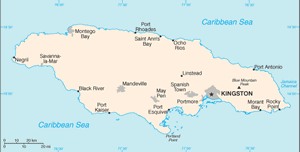The Geography of Jamaica
The Geography of Jamaica
Jamaican Geography
Location: Caribbean, island in the Caribbean Sea, south of Cuba
Geographic coordinates: 18 15 N, 77 30 W
Map references: Central America and the Caribbean
Area: total: 10,991 sq km land: 10,831 sq km water: 160 sq km
Area - comparative: slightly smaller than Connecticut
Land boundaries: 0 km
Coastline: 1,022 km
Maritime claims: measured from claimed archipelagic straight baselines territorial sea: 12 nm contiguous zone: 24 nm exclusive economic zone: 200 nm continental shelf: 200 nm or to edge of the continental margin
Climate: tropical; hot, humid; temperate interior
Terrain: mostly mountains, with narrow, discontinuous coastal plain
Elevation extremes: lowest point: Caribbean Sea 0 m highest point: Blue Mountain Peak 2,256 m
Natural resources: bauxite, gypsum, limestone
Land use: arable land: 15.83% permanent crops: 10.01% other: 74.16% (2005)
Irrigated land: 250 sq km (2002)
Natural hazards: hurricanes (especially July to November)
Environment - current issues: heavy rates of deforestation; coastal waters polluted by industrial waste, sewage, and oil spills; damage to coral reefs; air pollution in Kingston results from vehicle emissions
Environment - international agreements: party to: Biodiversity, Climate Change, Climate Change-Kyoto Protocol, Desertification, Endangered Species, Hazardous Wastes, Law of the Sea, Marine Dumping, Marine Life Conservation, Ozone Layer Protection, Ship Pollution, Wetlands signed, but not ratified: none of the selected agreements
Geography - note: strategic location between Cayman Trench and Jamaica Channel, the main sea lanes for the Panama Canal


